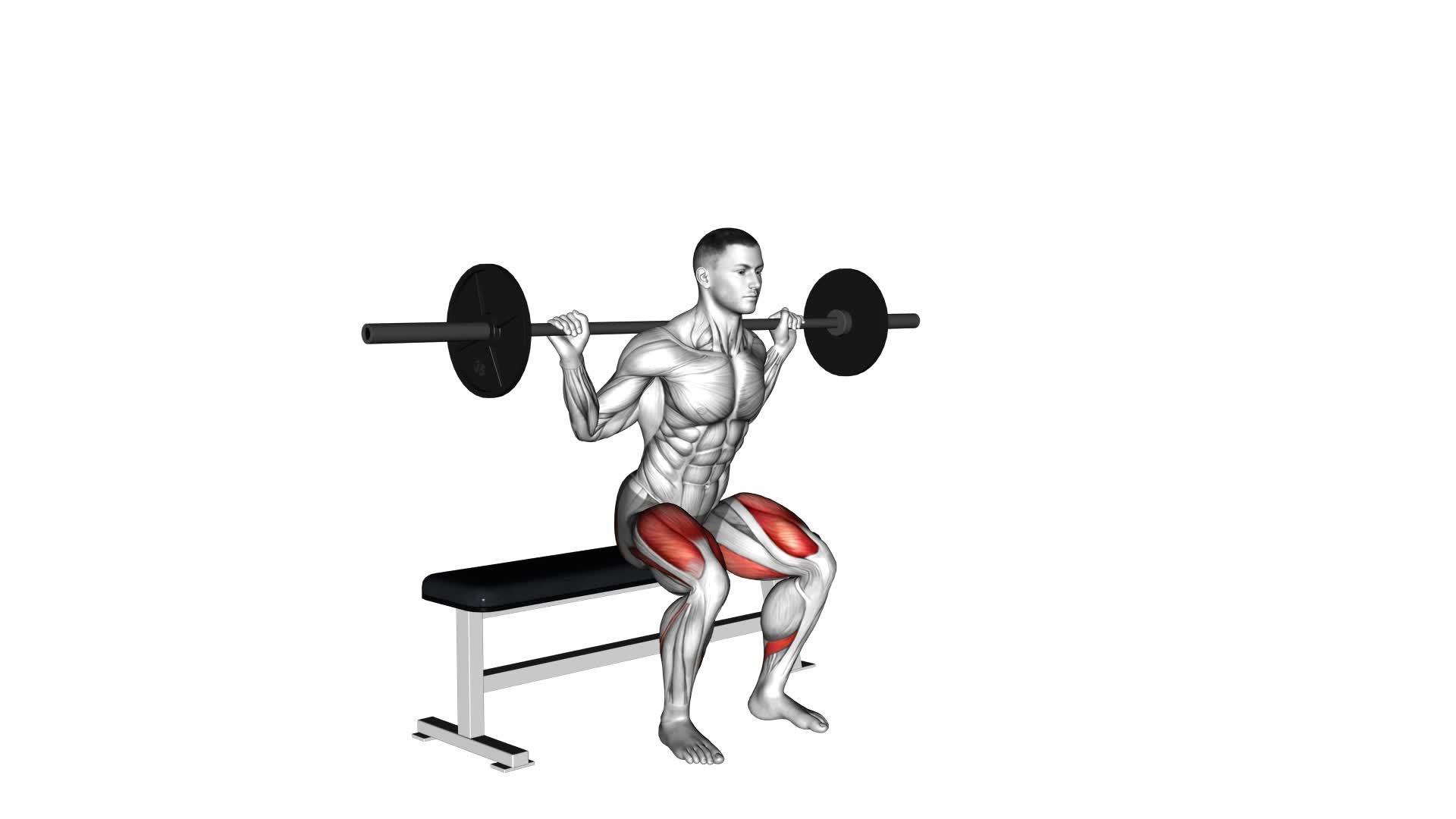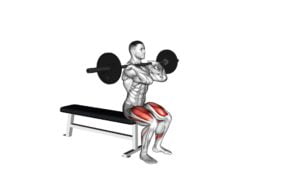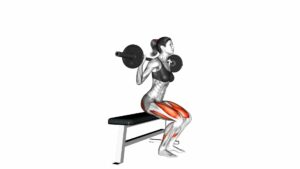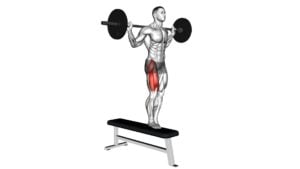Barbell Bench Squat – Video Exercise Guide & Tips

Ever struggled to nail the perfect form while doing a barbell bench squat? This popular exercise targets multiple muscle groups, but only if performed correctly. In this comprehensive guide, you’ll find invaluable tips and techniques for mastering the barbell bench squat, empowering you with knowledge to make every rep count.
Watch This Exercise Video
Ready for maximum results? Let’s dive in!
Key Takeaways
- The barbell bench squat targets muscles such as the quads, hamstrings, and glutes while strengthening joints and ligaments.
- Performing barbell bench squats can improve stability and durability in your knees, ankles, and hips, reducing the risk of injury during other compound exercises.
- Incorporating barbell bench squats into your workout routine can benefit other compound exercises like deadlifts, bench presses, and lunges by increasing overall strength and stability.
- To perform a barbell bench squat with proper form: position the barbell on your upper back, keep feet shoulder-width apart with toes slightly turned out, engage core muscles throughout the movement.
Barbell Bench Squat Overview
The barbell bench squat targets muscles such as the quads, hamstrings, and glutes, while also strengthening joints and ligaments. It provides benefits for compound exercises like deadlifts, bench presses, and lunges.
Targeted muscles (quads, hamstrings, glutes)
Performing the barbell bench squat exercise targets critical lower body muscles for maximum results. The prime movers are your quadriceps, located on the front of your upper legs. Alongside quads, this compound exercise intensively works your hamstrings and glutes, which provide power and stabilization during the movement.
Glutes bear a heavy load while squatting down and driving up from a deep position to standing straight. Meanwhile, hamstrings act as synergist muscles assisting in hip extension alongside glutes and knee flexion with quads.
This triple impact makes barbell bench squats one of the most effective exercises for strengthening these muscle groups simultaneously.
Strengthening of joints and ligaments
Strengthening joints and ligaments is one of the key benefits of the barbell bench squat. This exercise targets not only your muscles but also the connective tissues that support your joints.
By regularly performing barbell bench squats, you can improve the stability and durability of your knees, ankles, and hips. Strong joints and ligaments are crucial for preventing injuries during other compound exercises like deadlifts, bench presses, and lunges.
Incorporating this exercise into your workout routine will help ensure maximum effectiveness in all areas of your fitness journey.
Benefits for compound exercises (deadlift, bench press, lunge)
Compound exercises such as the deadlift, bench press, and lunge can benefit greatly from incorporating barbell bench squats into your workout routine. By performing this exercise, you strengthen not only your quads, hamstrings, and glutes but also the joints and ligaments in these areas.
This increased strength and stability can then be transferred to other compound exercises, helping you maximize your results and improve overall performance in your workouts.
How to Perform a Barbell Bench Squat
To perform a Barbell Bench Squat, start by positioning a barbell securely on the bench behind you. Lower yourself onto the bench and position your feet shoulder-width apart, with your toes pointed slightly outward.
Grasp the barbell with an overhand grip and carefully lift it off the bench, ensuring that your back is straight and core muscles are engaged. Slowly descend into a squatting position by bending at the knees and hips until your thighs are parallel to the floor or slightly below.
Push through your heels to return to the starting position, keeping your chest lifted throughout the movement. Repeat for desired repetitions while maintaining proper form and technique.
Proper form and technique
To perform a barbell bench squat with proper form and technique, start by positioning the barbell across your upper back. Stand with your feet shoulder-width apart and toes slightly turned out.
Engage your core and keep your chest up as you lower yourself down into a squatting position, keeping your knees in line with your toes. Make sure to push through your heels as you stand back up to the starting position.
This will help to activate the muscles in your quads, hamstrings, and glutes while also protecting your joints and ligaments during the exercise. Remember to maintain control throughout the movement, avoiding any sudden jerking motions or excessive leaning forward or backward.
Tips for correct execution
To perform the barbell bench squat with correct execution, there are several tips to keep in mind. First, ensure that your feet are shoulder-width apart and toes pointed slightly outward.
This will provide a stable base for the movement. As you lower into the squat position, focus on keeping your back straight and chest lifted. It’s important to maintain good posture throughout the exercise to avoid strain or injury.
Another tip is to descend slowly and control the movement as you lower yourself down into the squat position. This helps engage your muscles more effectively and maximizes results.
Additionally, make sure that your knees track in line with your toes throughout the movement.
Lastly, as you push up from the squat position, exhale and drive through your heels to activate your glutes and leg muscles properly. Remember to maintain a steady pace throughout each repetition without any jerky movements.
Assistance Exercises for Barbell Bench Squat
Some assistance exercises for the barbell bench squat include front squats, goblet squats, split squats, and Bulgarian split squats.
Front squats
Front squats are a great variation of the barbell bench squat that target the same muscles, but with added emphasis on the quads and core. To perform a front squat, grip the barbell in front of your body, resting it on your shoulders.
Keep your elbows high and chest up as you lower into a squat position, making sure to keep your knees tracking over your toes. Front squats help improve posture, increase upper body strength, and enhance overall stability.
By incorporating front squats into your workout routine, you can further develop leg strength and maximize results from your barbell bench squats.
Goblet squats
Goblet squats are an excellent assistance exercise to complement your barbell bench squats. This squat variation targets your quads, hamstrings, and glutes while also improving your core stability and posture.
To perform a goblet squat, hold a kettlebell or dumbbell close to your chest with both hands. Stand with your feet shoulder-width apart and lower down into a squat by bending at the knees and hips.
Keep your torso upright and maintain proper form throughout the movement. Goblet squats can help increase leg strength, improve depth in your squats, and enhance overall lower body power.
Split squats
To target your quads, glutes, and hamstrings, split squats are an excellent addition to your lower body workout routine. This exercise involves standing with one foot in front of the other and lowering your back knee towards the ground while keeping your front knee directly above your ankle.
By focusing on each leg individually, split squats help improve balance and stability while activating multiple muscles groups at once. To maximize the benefits of this exercise, maintain proper form by keeping your chest upright and core engaged throughout the movement.
Additionally, you can progress in split squats by adding weights or increasing repetitions as you gain strength.
Bulgarian split squats
Bulgarian split squats are a challenging variation of the traditional squat exercise that specifically target your legs and glutes. To perform Bulgarian split squats, start by standing with one foot forward and the other foot resting on a bench or elevated surface behind you.
Lower down into a lunge position, making sure your front knee stays in line with your ankle. Push through your front heel to stand back up. This exercise helps to build lower body strength and stability while also improving balance and flexibility.
It’s a great addition to any leg workout routine and can help you achieve maximum results in your fitness journey.
Progressing in Barbell Bench Squats
To progress in Barbell Bench Squats, focus on achieving a new personal record and setting weight goals.
Achieving a new personal record
Achieving a new personal record in barbell bench squats is an exciting milestone that can fuel motivation and show progress in your fitness journey. By gradually increasing the weight you lift, you can challenge yourself to push past previous limits and reach new heights of strength and endurance.
It’s important to approach this goal with patience and proper technique, focusing on maintaining good form while progressively adding more weight over time. With dedication and consistency, reaching a new personal record in barbell bench squats is within your grasp.
Setting weight goals
Setting weight goals is an important aspect of progressing in barbell bench squats. By setting specific and achievable goals for the amount of weight you want to lift, you can track your progress and continually challenge yourself.
Whether it’s increasing the weight by a certain amount each week or aiming for a new personal record, having a clear target can motivate you to push harder during your workouts. Remember to start with weights that are challenging but manageable, and gradually increase the load as your strength improves.
By setting weight goals, you can take your barbell bench squats to the next level and see maximum results in your lower body strength and overall fitness journey.
In addition to tracking progress and staying motivated, setting weight goals also helps ensure proper progression in barbell bench squats. It allows you to have a structured plan in place rather than aimlessly lifting heavier weights without a purpose.
This not only reduces the risk of injury but also ensures that you’re working towards realistic targets instead of attempting lifts that may be too heavy for your current strength level.
Conclusion
In conclusion, the barbell bench squat is a powerful exercise that targets the quads, hamstrings, and glutes while also strengthening joints and ligaments. By incorporating this compound exercise into your routine, you can enhance other movements like deadlifts, bench presses, and lunges.
To maximize your results, make sure to focus on proper form and technique and consider trying different variations of squats for added challenge. Keep pushing yourself to achieve new personal records and set weight goals to continue progressing in your barbell bench squats.
Let’s get stronger together!
FAQs
1. What is a Barbell Bench Squat?
The Barbell Bench Squat is a leg strength exercise that uses a barbell for added resistance and focuses on lower body workouts like glute activation and hamstring strengthening.
2. Are there variations to the Barbell Back Squat?
Yes, multiple squat variations can help engage different muscle groups or angles, but always maintaining proper squat technique for safety.
3. How does the Barbell Bench Press differ from the Barbell Squat?
While both are barbell exercises used in weightlifting; the bench press targets upper body strength while squats focus on lower body strength including glutes and hamstrings.
4. Can you give some tips for improving my squatting form?
To improve your squatting form, keep your back straight, descend until thighs are at least parallel with the floor, keep knees over toes and avoid letting them buckle inwards.
5. Where can I find a workout guide that includes this exercise?
Our “Barbell Bench Squat – Video Exercise Guide & Tips” provides you with detailed instructions on performing this weightlifting technique along with other useful fitness tips.

Author
Years ago, the spark of my life’s passion ignited in my mind the moment I stepped into the local gym for the first time. The inaugural bead of perspiration, the initial endeavor, the very first surge of endorphins, and a sense of pride that washed over me post-workout marked the beginning of my deep-seated interest in strength sports, fitness, and sports nutrition. This very curiosity blossomed rapidly into a profound fascination, propelling me to earn a Master’s degree in Physical Education from the Academy of Physical Education in Krakow, followed by a Sports Manager diploma from the Jagiellonian University. My journey of growth led me to gain more specialized qualifications, such as being a certified personal trainer with a focus on sports dietetics, a lifeguard, and an instructor for wellness and corrective gymnastics. Theoretical knowledge paired seamlessly with practical experience, reinforcing my belief that the transformation of individuals under my guidance was also a reflection of my personal growth. This belief holds true even today. Each day, I strive to push the boundaries and explore new realms. These realms gently elevate me to greater heights. The unique combination of passion for my field and the continuous quest for growth fuels my drive to break new ground.







